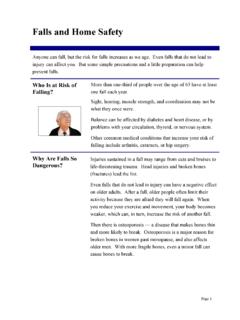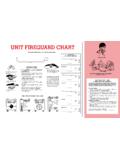Transcription of Indoor Air Quality Assessment Checklist
1 Indoor AIR QUALITYI ndoor Air QualityAssessment ChecklistB3439 You can use this Checklist to:1) determine if health symptoms experienced at home are the result of an Indoor air- Quality problem;2) isolate probable sources of an air- Quality problem; and3) evaluate a home for potential problems when symptoms are not Checklist is not suitable for certifying a home is free from air- Quality problems. If you need such certification, contactlocal or state health officials for names of appropriate professional engineering Checklist includes several parts. The first is an Assessment of symptoms. This is followed by a series of questionsdesigned to determine if symptoms are linked to the home . The remaining sections pose questions pertaining to each ofseveral major Indoor air Quality contaminants.
2 For each contaminant there is a reference for further information. Description of SymptomsComplete the table below using names to distinguish various household members. The other information is to help evaluatethe air Quality problem. Known health problems, allergies for example, should be listed only if they are related to air qualitysymptoms. Indicate which persons have problems by placing the symptom codes, listed below, for that person in the AirQuality Symptoms Health Problem(s)Air Quality Symptom(s)(first name)(use codes below) Quality Symptoms - Several health symptoms are described below. List the letter(s) as appropriate. For example, if afamily member is experiencing nausea note the letter b under health symptoms for that no symptomsf. nasal congestion/runny noseb.
3 Nauseag. dizzinessc. eye irritationh. headached. burning or stinging eyesi. other describee. respiratory which room or rooms do these symptoms usually occur? what time of day do these symptoms usually occur?_____Elaine AndrewsJohn L. Merrill2 Is It an Indoor -Air Quality Problem? were symptoms first noticed? (month and year) do health symptoms occur, or when are they the worst?__ spring__ summer__ fall__ winter__ all year__ not sure__ symptoms persist when the individual leaves the home ? __ Yes__ any new events, changes or hobbies in your home environment that beganwithin a month of the date given in question number 1. If you identify changes in thehome environment, turn to the section(s) of the Assessment that match the letter inparentheses after the new home (B, C, D & F)__ recently moved into home (B, C, D, E, F & G)__ new construction (B, D, F & H)__ new smoker (A, B & F)__ new weatherization (B, D, G & H)__ new carpet (B & F)__ new furnishings (B & F)__ new furnace (with its own air supply) (B & G)__ addition of gas heating, cooking or clothes dryer (B & G)__ new hobby using varnishes, paints, stains, etc.
4 (A, B & D)__ additional use of home , pet or plant pesticides (B & E)__ persistent odors, describe:_____ other, was your home built? your home was built before 1975, indicate whether any of the following types ofmaterials are present:__ plaster-like or corrugated-paper pipe insulation on hot or cold water pipes__ boiler insulation__ felt-like covering on warm-air ductUnless you know the composition, ceiling or floor tiles should be analyzedfor asbestos before disrupting. If you answered yes to one or more of thesequestions, asbestos fibers might be in the air of your home . Exposure tothese fibers increases your chances of developing cancer. See UW-Extension publication Stalking Friable Asbestos in the home (B3443) forfurther home many floors does your home have?
5 (Do not count basement unless it is routinelyused for living space.)# floors how many square feet are there on each floor? The basement should beconsidered a floor only if it is routinely used for living space. Multiply the width of thehouse by its length to find the square #1_____floor #2_____floor #3_____other floors_____Total of home :__ incomplete __ less than 1 year__ 5-25 years__ 1-5 years__ more than 25 , check which ones are used in home :__ window weatherstripping__ door weatherstripping__ new windows or storms__ plastic on windows__ wall or ceiling air/vapor retarder__ fans are located in: __ kitchen __ bathrooms __ fans are used:__ regularly, whenever room is occupied__ occasionally, when needed__ never__ don t air conditioning present?
6 __ Yes__ other house ventilation systems ( attic fans, air-to-air heat exchangers used)?__ Yes__ NoIf yes, what are they? signs of mold growth visible?__ Yes__ No10. Do you have persistent condensation on windows in winter? __ Yes__ NoInadequate ventilation can cause concentrations of contaminants to increaseand can result in high humidity levels. See UW-Extension publicationMoisture Problems in the home (B3371) for further information and remainingsections of this Checklist for more detailed questions about is not responsible for any known short-term health , exposure increases the chances of developing lung cancer. SeeUW-Extension publication Radon Gas in the home (B3442) for and your family do more than occasional woodworking or hobby activity in the home ?
7 __ Yes__ NoIf yes, describe: your family daily use any aerosol sprays in the home ? __ Yes__ the cleaning products you frequently use:__ oven cleaners__ carpet shampoos__ ammonia__ tub-and-tile cleaners__ disinfectants__ air fresheners__ dusting sprays or furniture polishes__ self-cleaning floor waxes__ general-purpose household cleaners__ dry-cleaning fluids or spot removers__ home cleaners in aerosol spray form__ scouring powders that contain chlorine you use or store mothballs in your home ?__ Yes__ any of the following products you frequently use in your home ?__ paint stripper__ paint thinner__ wood stains__ turpentine__ furniture polish__ artist s paints__ mineral spirits__ varnish, lacquer or you store any of the following in your house?
8 __ paints__ solvents__ kerosene__ lubricating greases or oils__ pool you frequently dry clean clothing or household furnishings?__ Yes__ NoMany of these solvents have been linked to short-term health problems suchas nausea or dizziness and long-term health problems such as cancer or birthdefects. If answers to questions in this section indicate frequent exposure tosolvents see UW-Extension publication Solvents: Chemical Hazards in theHome (G3027). you store any of the following in your house?__ pesticides__ herbicides__ you have large numbers of plants indoors?__ Yes__ you frequently use pesticides indoors on pets, house plants or insects?__ Yes__ you ever had your home treated for insects or other pests? __ Yes __ NoIf so, give most recent date and name of product are poisons.
9 More than occasional use of pesticides in your homeand surrounding area may cause respiratory problems. If you areexperiencing health problems you suspect are associated with pesticides,consult your physician or local health professional as soon as possible. SeeUW-Extension publication Pesticides: Chemical Hazards in the home (G3026)for more composition wood products such as particleboard, furniture or cabinets been usedextensively in home construction in the last two year?__ Yes__ new carpeting been installed in the home in the last two years?__ Yes__ NoIf yes, was it installed over concrete?__ Yes__ new drapes, rugs or upholstery been installed in the home in the last two years?__ Yes__ NoExposure to formaldehyde can cause a variety of symptoms, includingburning eyes and respiratory problems.
10 See UW-Extension publicationFormaldehyde in the home (B3441) for more you have a frequent smoker (smokes more than one pack per day) in the home ?__ Yes__ you have an attached garage?__ Yes__ you use a gas stove or oven for cooking?__ Yes__ old is your gas stove or oven?_____ you have a gas water heater?__ Yes__ your primary winter heat source a:__ fireplace__ coal furnace or boiler__ oil furnace or boiler__ gas furnace or boiler__ wood stove or furnace__ active or passive solar heat__ electric furnace or boiler (LP or natural)__ electric baseboard or space heater__ unvented gas or kerosene space you use a backup or supplementary heating system, it is a:__ oil furnace or boiler__ combination furnace__ gas furnace or boiler__ wood stove or furnace__ fireplace__ electric baseboard or space heater__ electric furnace or boiler (LP or natural)__ active or passive solar heater__ unvented gas or kerosene space old is your primary heating source?





